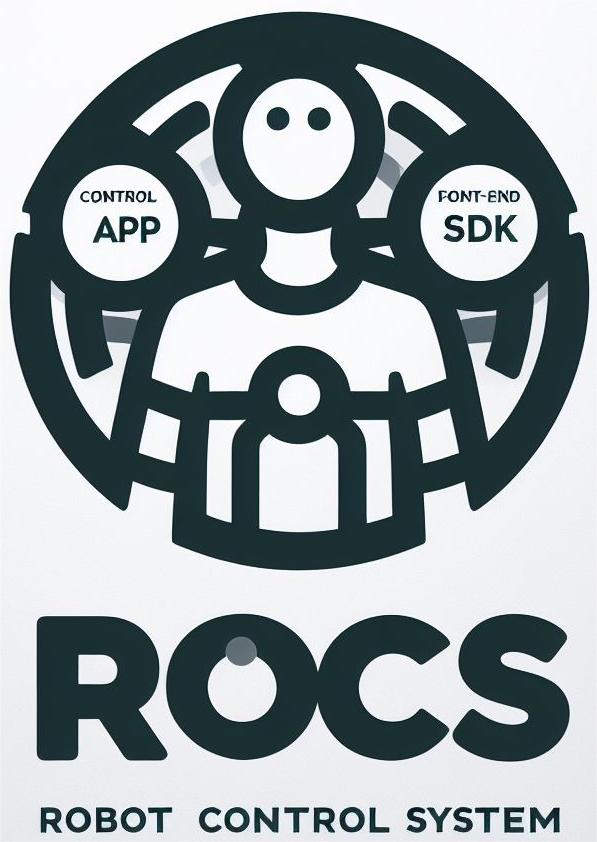Fourier General Robotics OS - Client Library (python)
Project description
RoCS-Client SDK (python)
Overview
This example (RoCS Client SDK) is suitable for you already have a robot device provided by Fourier! This example can be used to control the robot. It provides a set of simple APIs that allow you to easily interact with the robot.
Installation
pip install rocs_client
Function introduction
You can use the following methods to control the robot
- _control_svr_start(): Turn on the robot control program
- _control_svr_status(): View the running status of the robot
- _control_svr_log_view(): View robot run logs
- _control_svr_close(): Turn off the robot control program
- start(): Zero/Start control
- stop(): Emergency stop (will stop with power off)
- exit(): Exit robot control
- stand(): Stand in place
- walk(angle, speed): Control the robot to move, walk
- angle(float): Angle controls direction, range is plus or minus 45 degrees. Left is positive, right is negative! ( Floating point number with 8 digits)
- speed(float): Speed controls forward and backward, range is plus or minus 0.8. Forward is positive, backward is negative! (Floating point number with 8 digits)
- head(roll, pitch, yaw): Control GR-01 humanoid head movement
- roll(float): roll (roll angle): describes the angle of rotation around the x-axis, left turn head is negative, right turn is positive, range (-17.1887-17.1887)
- pitch(float): pitch (pitch angle): describes the angle of rotation around the y-axis. Nodding forward is positive, nodding backward is negative, range (-17.1887-17.1887)
- yaw(float): yaw (yaw angle): describes the angle of rotation around the z-axis. Turning left head is negative, turning right head is positive, range (-17.1887-17.1887)
- upper_body(arm_action, hand_action): Upper limb preset command
- arm_action(ArmAction): Arm preset command enumeration
- hand_action(HandAction): Hand preset command enumeration
Usage
Import sdk
First, you need to import this SDK in your Python code
import rocs_client # Import root
Create a robot object
Then, you need to create a robot object in order to use this SDK
from rocs_client import Human # Import Human as needed, similarly there are Car, Dog, etc.
human = Human(host='192.168.12.1') # Please replace host with the ip of your device
Sample Code
Below is a complete sample code that demonstrates how to use this SDK to control a robot:
Whole machine control (rocs_client>=1.0)
import time
from rocs_client import Human
from rocs_client.robot.human import ArmAction, HandAction
human = Human(host='192.168.9.17') # Please replace host with the ip of your device
human.start() # Start remote control
time.sleep(
10) # Control system built-in state machine. To ensure normal calibration and startup of the robot, it is recommended to execute subsequent instructions after start() instruction for 10s
human.stand() # Stand up
human.upper_body(arm=ArmAction.LEFT_ARM_WAVE) # Wave left hand
human.upper_body(hand=HandAction.TREMBLE) # Tremble fingers
human.stand() # Stand up
human.walk(0, 0.1) # Move forward at a speed of 0.1
Single motor control (rocs_client>=1.3.0)
import math
import threading
import time
from rocs_client import Human
human = Human(host="192.168.9.17") # Please replace host with the ip of your device
motors = human.motor_limits[0:15]
def set_pds_flag():
for motor in motors:
human.set_motor_pd_flag(motor['no'], motor['orientation'])
human.exit()
def set_pds():
for motor in motors:
human.set_motor_pd(motor['no'], motor['orientation'], 0.36, 0.042)
human.exit()
def enable_all():
for motor in motors:
human.enable_motor(motor['no'], motor['orientation'])
time.sleep(1)
def _disable_left():
for i in range((len(motors) - 1), -1, -1):
motor = motors[i]
if motor['orientation'] == 'left':
smooth_move_motor_example(motor['no'], motor['orientation'], 0, offset=1, wait_time=0.04)
for i in range((len(motors) - 1), -1, -1):
motor = motors[i]
if motor['orientation'] == 'left':
human.disable_motor(motor['no'], motor['orientation'])
def _disable_right():
for i in range((len(motors) - 1), -1, -1):
motor = motors[i]
if motor['orientation'] != 'left':
smooth_move_motor_example(motor['no'], motor['orientation'], 0, offset=1, wait_time=0.04)
for i in range((len(motors) - 1), -1, -1):
motor = motors[i]
if motor['orientation'] != 'left':
human.disable_motor(motor['no'], motor['orientation'])
def disable_all():
time.sleep(2)
t_left = threading.Thread(target=_disable_left)
t_right = threading.Thread(target=_disable_right)
t_left.start(), t_right.start()
t_left.join(), t_right.join()
human.exit()
def wait_target_done(no, orientation, target_angle, rel_tol=1):
while True:
p = human.get_motor_pvc(str(no), orientation)['data']['position']
if math.isclose(p, target_angle, rel_tol=rel_tol):
break
def smooth_move_motor_example(no, orientation: str, target_angle: float, offset=0.05, wait_time=0.004):
if int(no) > 8:
print('than 8 not support')
return
current_position = 0
while True:
try:
current_position = (human.get_motor_pvc(no, orientation))['data']['position']
if current_position is not None and current_position != 0:
break
except Exception as e:
pass
target_position = target_angle
cycle = abs(int((target_position - current_position) / offset))
for i in range(0, cycle):
if target_position > current_position:
current_position += offset
else:
current_position -= offset
human.move_motor(no, orientation, current_position)
time.sleep(wait_time)
wait_target_done(no, orientation, current_position)
"""
This is the action of simple
When you first single-control a motor, I strongly recommend that you must run this function for testing
If the motor's motion is linear and smooth, then you can try something slightly more complicated
But if it freezes, you need to debug your P and D parameters.
"""
human.enable_motor('2', 'left')
time.sleep(2)
smooth_move_motor_example('2', 'left', -10)
smooth_move_motor_example('2', 'left', -20)
smooth_move_motor_example('2', 'left', -10)
time.sleep(2)
human.disable_motor('2', 'left')
Single Control Hand (rocs_client>=1.3.2)
from rocs_client import Human
human = Human(host="192.168.137.210")
def enable_hand():
human.enable_hand()
human.exit()
def disable_hand():
human.disable_hand()
human.exit()
def test_get_hand_position(self):
human.move_motor('9', 'left', 100)
human.move_motor('10', 'left', 150)
human.move_motor('11', 'left', 200)
print(human.get_hand_position())
human.exit()
Journey
| Version | Author | Date | Description | Quick Preview |
|---|---|---|---|---|
| 0.1 | Fourier Software Department | 2023.8 | 1. Project initiation 2. Confirm basic architecture |
0.1 Description |
| 0.2 | Fourier Software Department | 2023.9 | 1. Control module, system module 2. Specific coding |
0.2 Description |
| 1.1 | Fourier Software Department | 2023.10 | 1. Hand, head preset actions 2. Single joint control of upper body |
1.1 Description |
| 1.2 | Fourier Software Department | 2023.11 | smooth movement example for single motor control | |
| 1.3 | Fourier Software Department | 2023.12 | Dexterous hand separate control |
Project details
Release history Release notifications | RSS feed
Download files
Download the file for your platform. If you're not sure which to choose, learn more about installing packages.
Source Distribution
rocs_client-1.3.2.tar.gz
(232.8 kB
view hashes)
Built Distribution
Close
Hashes for rocs_client-1.3.2-py3-none-any.whl
| Algorithm | Hash digest | |
|---|---|---|
| SHA256 | 5b9e38711c92e9629064b5495ab4cb5e0c41700006ea90e7e3896d1c0ca31003 |
|
| MD5 | 42ff9cabf5e1087655c2ccd9a07468ff |
|
| BLAKE2b-256 | 903c80e36c3dd27dd19fb8f8d074fc86cd282108b68f305deddc4b6aa5b8172c |













